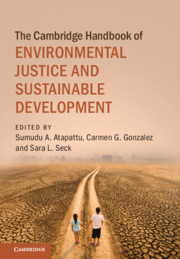Book contents
- The Cambridge Handbook of Environmental Justice and Sustainable Development
- The Cambridge Handbook of Environmental Justice and Sustainable Development
- Copyright page
- Contents
- Contributors
- Acknowledgments
- Foreword (on Living in an Interregnum)
- 1 Intersections of Environmental Justice and Sustainable Development
- Part I Frameworks
- 2 The Indivisibility of Human Dignity and Sustainability
- 3 Environmental Justice in the Global South
- 4 Indigenous Environmental Justice and Sustainability
- 5 Racial Capitalism and the Anthropocene
- 6 Human Rights and Socioecological Justice through a Vulnerability Lens
- 7 Social–Ecological Resilience and Its Relation to the Social Pillar of Sustainable Development
- 8 Environmental Justice and Sustainability
- Part II Case Studies
- Part III Conclusion
- Index
5 - Racial Capitalism and the Anthropocene
from Part I - Frameworks
Published online by Cambridge University Press: 26 March 2021
- The Cambridge Handbook of Environmental Justice and Sustainable Development
- The Cambridge Handbook of Environmental Justice and Sustainable Development
- Copyright page
- Contents
- Contributors
- Acknowledgments
- Foreword (on Living in an Interregnum)
- 1 Intersections of Environmental Justice and Sustainable Development
- Part I Frameworks
- 2 The Indivisibility of Human Dignity and Sustainability
- 3 Environmental Justice in the Global South
- 4 Indigenous Environmental Justice and Sustainability
- 5 Racial Capitalism and the Anthropocene
- 6 Human Rights and Socioecological Justice through a Vulnerability Lens
- 7 Social–Ecological Resilience and Its Relation to the Social Pillar of Sustainable Development
- 8 Environmental Justice and Sustainability
- Part II Case Studies
- Part III Conclusion
- Index
Summary
This chapter introduces the framework of racial capitalism as a means of exploring the under-theorized relationship among environmental degradation, racial subordination, and the capitalist world economy. Using climate change as an example, the chapter illuminates the links between seemingly disparate forms of oppression in order to foster collaboration among scholars, policymakers, and social justice movements seeking systemic change.
- Type
- Chapter
- Information
- Publisher: Cambridge University PressPrint publication year: 2021
- 3
- Cited by

